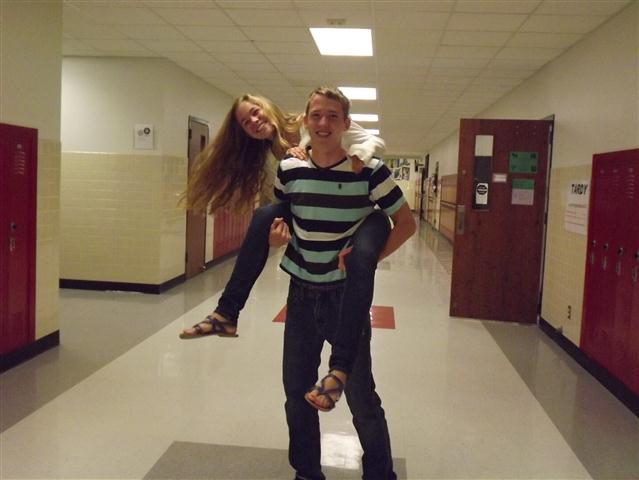A frozen beginning
Eight-year-olds Gabi and Gavin Harkrider, now juniors, snuck up behind their older sister. Then they screamed “Twin attack!” Megan Harkrider fell to the floor as the two tackled her, and they all exploded into laughter. Their mother, Becky Harkrider, smiled. She was given a second chance to have children. Had she not, the happiness she felt now wouldn’t have existed.
Back years ago, Becky made a decision that would change her life forever. Becky started the in vitro process because her fallopian tubes, which transfer eggs to the uterus, weren’t functioning. Even after several surgeries to fix them, they still failed to give her what she truly wanted – children.
But Becky was determined. She started to research in vitro fertilization. This is when a woman has her eggs removed from her ovaries, which are then fertilized and reimplanted into the uterus. This process has a very low success rate since the body does not recognize the embryo.
“It’s considered a very risky pregnancy to begin with because your body doesn’t know it’s pregnant yet,” Becky said.
On top of that, Becky would have to take hormone shots and go to multiple doctors’ visits. But nothing was going to stop her from trying to have children. She and her husband agreed that this was the best decision. Once she was sitting in the doctor’s office, the odds seemed to be in her favor when the doctor made a discovery.
“I had over 30 viable eggs, which is almost unheard of,” Becky said. “They were going nuts in the doctor’s office.”
According to the Emory Healthcare in Georgia, the most common number of eggs retrieved from a woman ranges from five to 15. Becky felt her luck change when she heard this promising news.
Once the eggs were removed and fertilized with her husband’s sperm, four out of the bunch were chosen and implanted in Becky. However, there were over 25 eggs left.
“So I had all these fertilized eggs, the question was, what do we do with all of them?” Becky said.
Becky’s remaining eggs were frozen. Then she had her first in vitro pregnancy with her eldest daughter Megan, who is now in college. All the treatments, the constant checkups and the medicine created a grueling, stressful routine for her and her husband.
“It was very costly and exhausting,” Becky said. “It wasn’t fun, but it’s something you do when you want to have children.”
But, Becky and her husband were excited to finally have a child of their own, after years of trying.
When Megan was about 6 months old, Becky’s doctor told her that if she wanted to have more children, she needed to do it right then. Becky didn’t care how soon it had been since her last pregnancy. She wanted children so she made the commitment.
“My mom told me that my dad and her went through a lot of stress to have us,” Gabi said. “Just years of tears and so much pain, but then they finally had an option.”
After implanting five embryos, Gavin and Gabi were born. Both pregnancies were considered unpredictable. According to Fertility Centers of New England, only about 40 to 50 percent of embryos actually survive transfer.
“There is just a lot of ‘ifs’ and ‘whats’ on what would happen,” Gavin said. “The chance that we were going to make it was slim.”
Even with their low chances, Gavin and Gabi were born healthy children. Today, they are typical teenagers. They both like track. They enjoy the TV show The Walking Dead and they are both artists. Growing up, the Harkrider twins didn’t realize how unique they were. Gabi said when she was first told about the process, she thought it was normal.
“I didn’t think it was anything special until I told other people about it, and they were like, ‘What!’” Gabi said.
The twins are also shocked at the idea that they might have been chosen first to be the older sibling since any of the eggs could have been chosen by the doctor.
“A lot of people don’t get the choice to be born first or second, but the ‘what if’ on our side is more complex,” Gavin said. “There is actually a decision that had to be made.”
Although the twins were born the same way as everyone else, due to their unconventional conception, they have faced some prejudice. According to Gabi, Becky did not tell the Catholic church about their conception so that they could get baptized.
“They wouldn’t have let us get baptized in our Catholic church because to them we were scientifically created, we weren’t made by God,” Gabi said.
At the time, in vitro fertilization and frozen embryo transfer were not as common. Gavin said that the church has now changed their ideas on baptizing babies that are from non-traditional conceptions.
Although there were many obstacles for Becky and her husband, she says she wouldn’t have it any other way.
“It’s terribly expensive to get into this,” Becky said. “You just need the mindset, if you want to have children, you do it. You march forward.”
Today doctors are improving their methods so that there are higher survival rates for embryos involved with in vitro fertilization and frozen embryo transfer.
“I think if anyone has the dream to have children, don’t ever give up,” Becky said. “Go for it. Talk to your doctors.”
Gavin and Gabi are glad that their mother was given a second chance because without it, they wouldn’t be here.
“I feel like I was given the chance at life to do something,” Gavin said. “Most people wouldn’t be here today if they had to be born the way we were, but for some reason, we are here now and we should take this miracle and do something with it.”







